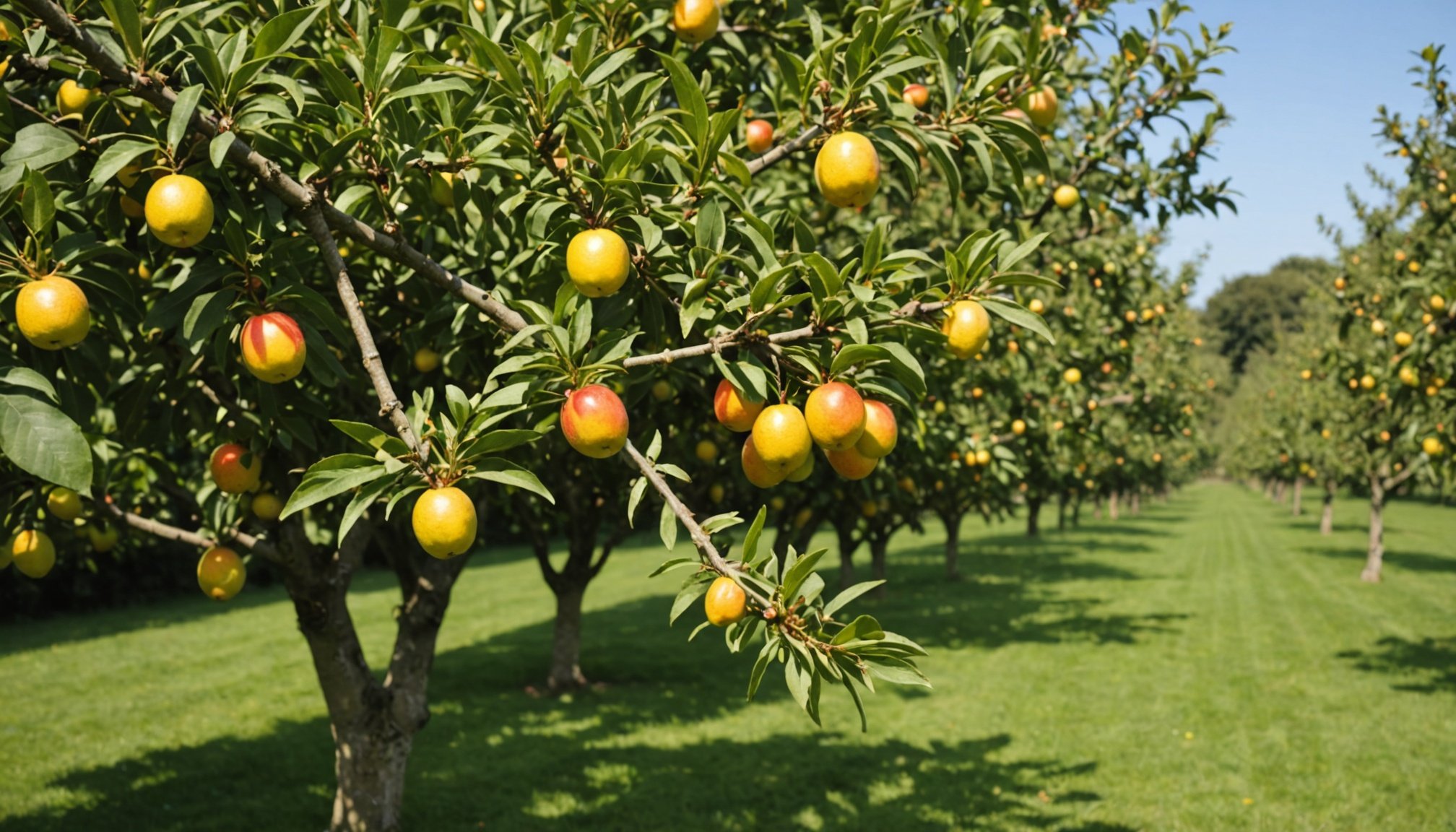Understanding the Importance of Pruning
Pruning is paramount for maintaining fruit tree health and enhancing fruit yield. It involves the selective removal of specific branches to boost the tree’s overall vitality. By reducing overcrowded areas within the tree, pruning enhances light penetration and air circulation. These improvements in the tree’s environment directly contribute to more substantial fruit production and optimal fruit tree health.
Seasonal pruning advantages are significant. Knowing when to prune can determine the effectiveness of the process. For instance, pruning during the dormant winter period helps in shaping the tree without risking excessive sap loss. Meanwhile, summer pruning can control growth and maintain tree size. Each season brings unique benefits that maximize the tree’s health and productivity.
En parallèle : Choosing the Perfect Indoor Plants for Low-Light UK Homes: A Care Guide
Many misconceptions about pruning persist. A typical one is that cutting back too much is detrimental. However, strategic pruning, rather than excessive cutting, ensures robust growth and abundant fruiting. Another misunderstanding is that pruning is unnecessary if a tree appears healthy. But regular maintenance helps prevent potential diseases and pests that aren’t immediately visible. Understanding these nuances will lead to more informed, beneficial practices.
Ideal Seasons for Pruning Fruit Trees
Pruning seasons and optimal timing are crucial for healthy fruit trees and maximum yield. Understanding when to prune your fruit trees can significantly impact their growth and fruit production.
Cela peut vous intéresser : Discover the Best Edible Mushrooms to Grow in the Shade of Your UK Backyard!
Winter Pruning Techniques
Winter is a perfect time for pruning fruit trees during dormancy. The absence of leaves provides clear visibility of the tree’s structure, aiding in precise cuts. Prune stone fruit trees like cherries and peaches using the open-centre technique, which promotes sunlight penetration and air circulation. Key indicators that winter pruning is necessary include crossed branches and dead wood.
Spring Pruning Guidelines
Spring pruning is best done just before buds break. This timing encourages vigorous growth and shapes trees for the growing season. The sight of multiple buds can guide you on where to cut. Focus on removing weak, spindly growth to direct energy to stronger branches, enhancing the overall yield.
Summer Pruning Insights
For certain fruit trees like apples, summer pruning helps in size control and encourages early fruiting. Techniques such as pinching back new shoots can be useful. However, avoid over-pruning in summer, as it can lead to sunburn on exposed trunks.
Autumn Pruning Recommendations
In autumn, pruning can prepare trees for winter, reducing the risk of disease. However, avoid heavy cuts late in the season, as new growth might not survive the cold. A light prune can help the tree focus on hardening off and energy conservation.
Pruning Techniques for Different Fruit Trees
Understanding how to prune fruit tree types effectively is essential for achieving robust growth and abundant fruit production. Each species benefits from specific tailoring of pruning methods to their natural growth patterns.
Pruning Apple Trees
When it comes to apple trees, species-specific pruning varies based on variety. Key techniques include removing dead or crossed branches to encourage air circulation. Common mistakes include excessive pruning which can stunt growth. Signs of healthy post-pruning development include strong, evenly distributed branches and consistent fruit blossom.
Pruning Pear Trees
Unique considerations for pear tree pruning involve understanding their distinct upright growth habit. Pruning during late winter can maximise seasonal yield by allowing the tree to focus its energy on budding when spring arrives. Maintaining an open-centered shape is vital to ensure sunlight penetrates the canopy, promoting healthy fruit ripening.
Pruning Stone Fruit Trees
Technique is crucial when pruning methods are applied to peach, plum, and cherry trees. Correct timing is paramount; pruning in early spring before budding can prevent spread of fungal infections. Regular checks for disease and pests are crucial since compromised trees require immediate pruning attention, which enhances overall tree health.
Common Pitfalls and Solutions
Navigating the world of pruning can sometimes lead to pruning mistakes that impact the health of plants. One frequent mistake is improper timing, such as pruning during the wrong season, which can result in reduced flowering or growth. Additionally, over-pruning can stress plants, causing them to be more susceptible to diseases and pests.
To effectively troubleshoot these issues, observe and identify signs of poor pruning practices. If plants aren’t growing as expected or if unusual patterns in flowering are noticed, consider reassessing your techniques. It’s essential to understand the needs of each specific plant type, as different species have unique pruning requirements.
Effective pruning solutions often involve a mix of timing and technique adjustment. For example, using sharp and clean tools can minimise plant damage and disease spread. It’s also key to prune at the correct angle and location on the plant.
Continuous learning and adaptation are vital. Stay updated with the latest pruning guidelines, as various factors, such as climate change, can alter plant behaviours. Engaging in gardening forums or workshops can provide invaluable insights and allow for skill enhancement over time. Remember, correct pruning enhances plant health and yields.
Additional Resources and Expert Insights
Enhancing your fruit tree pruning skills requires ongoing learning and access to reliable resources. Many experts recommend books like “The Pruner’s Bible” for comprehensive guides on best practices. Online platforms such as gardening forums and websites like the Royal Horticultural Society offer extensive pruning resources essential for both beginners and seasoned gardeners.
For tailored expert advice, consider insights from interviews with professional arborists. They often emphasize the importance of understanding your specific fruit tree species, using the right tools, and recognising the optimal timing for pruning. This nuanced knowledge can significantly improve your pruning technique and tree health.
Local community workshops are another resource worth exploring. These gatherings provide hands-on experience and allow for direct interaction with professionals who can answer questions and demonstrate techniques. Additionally, gardening clubs and cooperative extensions usually share information about upcoming events or pruning courses.
By leveraging these resources, you’ll gain a richer understanding of the best practices for fruit tree care, tailored to your unique needs and environment. This ongoing education will help ensure the health and productivity of your orchard. With dedicated effort and the right tools, you can become proficient in fruit tree care, reaping the benefits of a bountiful harvest.
Visual Guides and Timelines
Visual aids are crucial for mastering the art of pruning. They transform complex information into digestible content, easily absorbed by both novice and experienced gardeners. Infographic guides simplify intricate procedures and offer step-by-step clarity that text alone may not convey. To enhance the understanding of pruning techniques, a well-designed infographic can display the optimal periods and methods for various plants.
Seasonal timelines serve as invaluable tools. They map out the best time frames for pruning different flora, ensuring gardeners align their actions with nature’s rhythm. For instance, an effective timeline might illustrate when to prune fruit trees in winter or rose bushes in late spring. Such visuals convey a practical, at-a-glance reference that supports decision-making and streamlines gardening practices.
Creating compelling guides involves a strategic blend of visuals, such as colour-coded charts and simplified diagrams. These should highlight critical stages and transitions within the pruning cycle. By incorporating pictorial representations of before-and-after stages, these visuals not only inform but inspire confidence in carrying out pruning tasks efficiently. An exemplar infographic might use diagrams to highlight branch angles and cutting positions, delineating techniques for enhanced plant health and growth.











